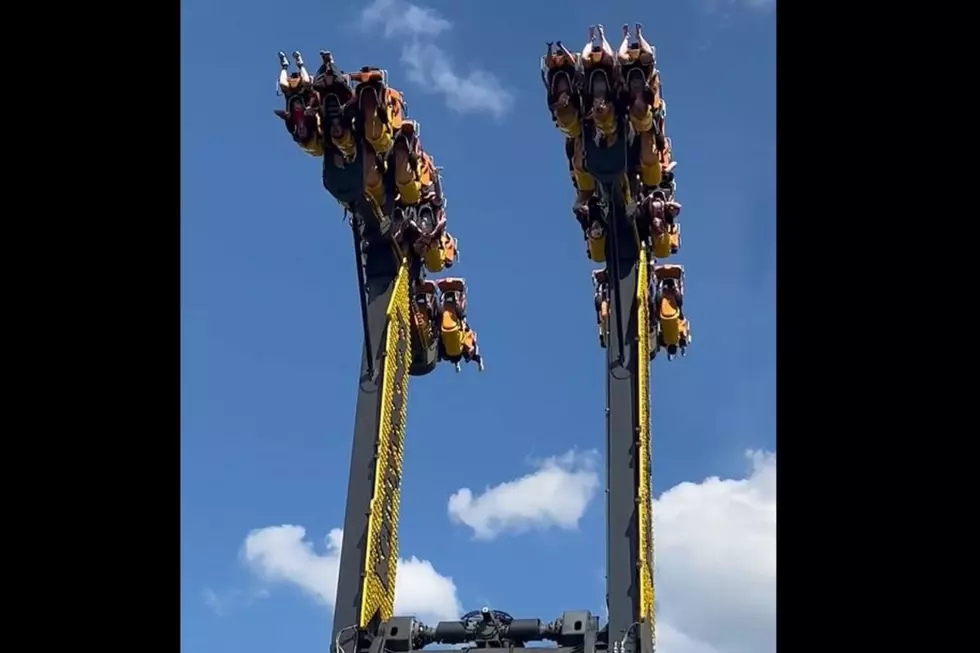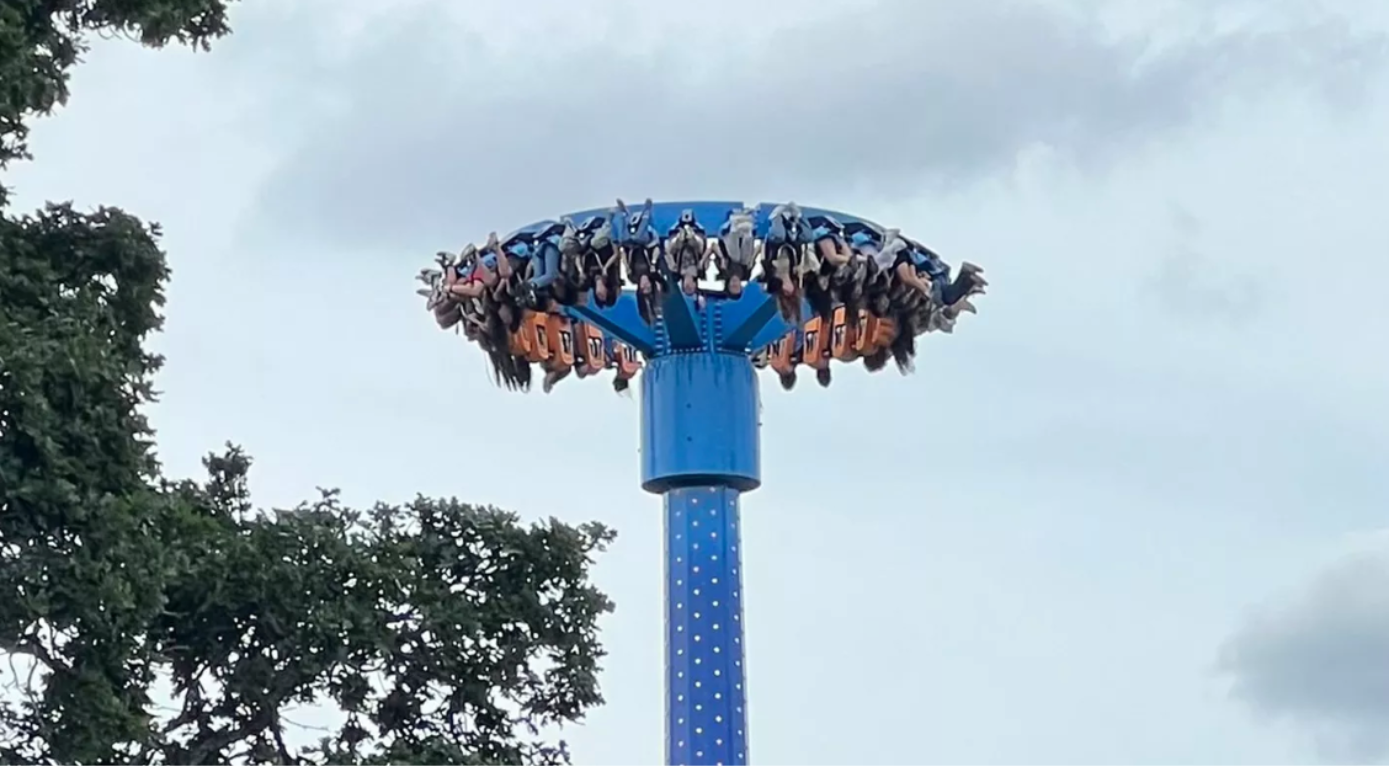Amusement Park Ride Gets Stuck Upside Down: Understanding The Incident And Ensuring Safety
Amusement park ride gets stuck upside down is a concerning incident that has captured global attention. Imagine the thrill of riding a roller coaster, only to find yourself hanging upside down for an extended period. Such events raise critical questions about safety measures, ride maintenance, and the responsibility of amusement parks to protect their visitors. In this article, we delve into the details of such incidents, analyze their causes, and explore ways to prevent them in the future.
While amusement parks are designed to provide fun and excitement, safety should always be the top priority. The recent incident of a ride getting stuck upside down has sparked debates about the reliability of these attractions. Understanding the factors that contribute to such mishaps is essential for both park operators and visitors.
This article aims to provide a comprehensive overview of the issue, offering insights into the technical aspects, safety protocols, and steps to ensure a safer amusement park experience. Whether you are a thrill-seeker or a concerned parent, this information will help you make informed decisions about your next visit to an amusement park.
Read also:Santa Cocoa The Ultimate Guide To The Festive Chocolate Delight
Table of Contents
- Introduction
- Details of the Incident
- Possible Causes
- Safety Protocols in Amusement Parks
- Importance of Regular Maintenance
- Regulations and Standards
- Preventive Measures
- Visitor Responsibility
- History of Similar Incidents
- Future Directions
Details of the Incident
On a seemingly ordinary day, an amusement park ride suddenly malfunctioned, leaving riders stranded upside down for several minutes. The incident occurred at a popular theme park, drawing widespread media coverage and public concern. While no serious injuries were reported, the experience left many shaken and questioning the safety of such attractions.
Amusement park ride gets stuck upside down incidents are not uncommon, but they highlight the need for improved safety measures. In this section, we will explore the specifics of the event, including the type of ride involved, the number of people affected, and the response of the park staff.
Timeline of Events
The ride in question was a high-speed roller coaster designed to simulate extreme thrills. The malfunction occurred during a routine run, when the ride unexpectedly stopped mid-air, leaving passengers hanging upside down. Emergency services were quickly alerted, and park staff initiated evacuation procedures. The entire process took approximately 30 minutes, during which passengers remained calm due to the park's effective communication and support.
Possible Causes
Several factors could contribute to an amusement park ride getting stuck upside down. Mechanical failures, human error, and environmental conditions are among the most common causes. Understanding these factors is crucial for preventing similar incidents in the future.
Common Causes
- Mechanical failures, such as brake malfunctions or chain breaks
- Software glitches in ride control systems
- Human error during operation or maintenance
- Unforeseen environmental factors, such as strong winds or lightning
Each of these causes requires a thorough investigation to identify the root problem and implement corrective actions. Amusement parks must prioritize regular inspections and staff training to minimize the risk of such incidents.
Safety Protocols in Amusement Parks
Amusement parks are required to adhere to strict safety protocols to ensure the well-being of their visitors. These protocols cover everything from ride design and maintenance to staff training and emergency response plans. In the case of amusement park ride gets stuck upside down incidents, the effectiveness of these protocols is put to the test.
Read also:Stephanie Hsu Debunking Misinformation And Focusing On Her Remarkable Career
Parks must conduct regular safety audits and comply with industry standards set by organizations such as ASTM International and IAAPA (International Association of Amusement Parks and Attractions). These standards outline the minimum requirements for ride safety, including structural integrity, operational procedures, and emergency preparedness.
Key Safety Measures
- Ride inspections before each operating day
- Staff training on emergency procedures
- Regular maintenance schedules
- Clear communication with riders about safety rules
Importance of Regular Maintenance
Maintenance is a critical component of amusement park safety. Regular inspections and upkeep of rides help identify potential issues before they escalate into serious problems. In the case of rides that get stuck upside down, preventative maintenance can significantly reduce the likelihood of such incidents occurring.
Parks should establish a comprehensive maintenance program that includes:
- Visual inspections of ride components
- Testing of safety mechanisms
- Replacement of worn-out parts
- Documentation of all maintenance activities
By prioritizing maintenance, amusement parks can ensure the longevity and safety of their attractions, providing a more enjoyable experience for visitors.
Regulations and Standards
Amusement parks operate under a framework of regulations and standards designed to ensure safety and compliance. These regulations vary by country but generally focus on ride design, operation, and maintenance. In the United States, for example, amusement rides are regulated by state and local authorities, with additional guidelines provided by industry organizations.
The ASTM International F24 Committee on Amusement Rides and Devices sets standards for ride safety, covering aspects such as:
- Ride design and manufacturing
- Operational safety
- Inspection and maintenance
- Emergency preparedness
Compliance with these standards is essential for preventing incidents like amusement park ride gets stuck upside down and ensuring a safe environment for all visitors.
Preventive Measures
Preventing ride malfunctions requires a multi-faceted approach that involves both park operators and visitors. Operators must invest in cutting-edge technology, adhere to maintenance schedules, and provide comprehensive staff training. Visitors, on the other hand, can contribute by following safety guidelines and reporting any concerns they may have.
Technological Solutions
Advancements in technology offer promising solutions for enhancing ride safety. For example, sensors and real-time monitoring systems can detect potential issues before they lead to malfunctions. Additionally, artificial intelligence can analyze data to predict maintenance needs, reducing the likelihood of unexpected breakdowns.
Visitor Responsibility
While amusement parks bear the primary responsibility for ensuring safety, visitors also play a role in preventing incidents. By following safety rules and guidelines, visitors can help maintain a secure environment for everyone. Key responsibilities include:
- Following height and weight restrictions
- Securing loose items before riding
- Listening to staff instructions
- Reporting any observed issues to park staff
By working together, park operators and visitors can create a safer and more enjoyable amusement park experience.
History of Similar Incidents
Incidents of amusement park rides getting stuck upside down are not isolated events. Over the years, several high-profile cases have highlighted the importance of safety measures and emergency preparedness. For example:
- In 2018, a roller coaster at a theme park in Ohio malfunctioned, leaving riders upside down for over an hour.
- In 2020, a ride in Japan experienced a similar issue, prompting an investigation into its safety systems.
These incidents underscore the need for continuous improvement in ride safety and emergency response strategies.
Future Directions
The future of amusement park safety lies in the integration of advanced technologies and enhanced regulatory frameworks. As parks continue to innovate, they must prioritize safety without compromising the thrill of their attractions. This involves:
- Investing in cutting-edge safety systems
- Enhancing staff training programs
- Collaborating with industry experts to develop new standards
By embracing these changes, amusement parks can set a new benchmark for safety and reliability, ensuring that incidents like amusement park ride gets stuck upside down become a thing of the past.
Kesimpulan
Amusement park rides getting stuck upside down are alarming events that highlight the need for improved safety measures and emergency preparedness. Through a combination of regular maintenance, adherence to regulations, and visitor responsibility, parks can significantly reduce the risk of such incidents occurring. As technology continues to evolve, the future of amusement park safety looks promising, offering hope for a safer and more enjoyable experience for all visitors.
We invite you to share your thoughts and experiences in the comments below. Have you ever encountered a similar incident? What steps do you think amusement parks should take to ensure safety? Don't forget to explore our other articles for more insights into the world of amusement parks and beyond.


